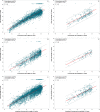Comparison of Bordetella species identification among differing rt-PCR assays in the United States
- PMID: 38980022
- PMCID: PMC11302660
- DOI: 10.1128/spectrum.00783-24
Comparison of Bordetella species identification among differing rt-PCR assays in the United States
Abstract
In the United States, the general laboratory method for diagnosing pertussis, caused by Bordetella pertussis, is real-time PCR (rt-PCR) targeting insertion sequence 481 (IS481). Other Bordetella species (parapertussis, holmesii, and bronchiseptica) can also cause a pertussis-like syndrome, and some commercial laboratory assays include the insertion sequence 1001 (pIS1001) that can detect B. parapertussis/B. bronchiseptica (BppBb). Because IS481 exists in B. pertussis and B. holmesii, current commercial assays cannot differentiate these two species. We used a multiplex rt-PCR assay containing species-specific targets to Bordetella to evaluate clinical specimens detected as B. pertussis/B. holmesii (BpBh) or BppBb by commercial laboratories. A sample of 3,984 clinical specimens positive for IS481 or pIS1001 from two commercial laboratories during 2012-2019 were re-tested at CDC. Agreement of Bordetella species between the CDC and commercial laboratory assays, and the proportion of commercial laboratory specimens that were non-B. pertussis by CDC's assay was assessed. Overall agreement in Bordetella species detection and identification between the CDC and commercial lab assays was 85%. Agreement for identifying B. pertussis was 87% for 3,663 BpBh specimens and 98% for identifying B. parapertussis in 310 BppBb specimens. CDC's assay detected B. holmesii in 55/3,984 (1.4%) specimens. Most discrepant results (410/490, 82%) were BpBh specimens interpreted as indeterminate B. pertussis at CDC. We found a small portion of B. holmesii in a sample of IS481-positive clinical specimens originally identified by commercial laboratory rt-PCR assays, suggesting that commercial PCR assays are a reliable diagnostic tool for correctly identifying Bordetella species in most patients with suspected pertussis.
Importance: When testing specimens collected from patients with suspected pertussis, large-scale commercial laboratories in the United States employ an IS481-based assay that cannot differentiate between Bordetella pertussis and Bordetella holmseii. The level of B. holmesii causing pertussis-like illness in the United States is not well-understood given that only B. pertussis is nationally notifiable. After re-testing with a multiplex, species-specific rt-PCR assay, our data show low levels of B. holmesii identified in a sample of IS481-positive clinical specimens originally identified by commercial laboratory rt-PCR assays. These results reinforce the validity of large-scale commercial rt-PCR testing as a reliable diagnostic tool for pertussis in the United States.
Keywords: Bordetella holmesii; Bordetella parapertussis; Bordetella pertussis; Bordetella real time-PCR; non-pertussis Bordetella; pertussis diagnostics; pertussis surveillance.
Conflict of interest statement
Contributing author Dr. Clemente Montero is an employee of Quest Diagnostics, and contributing author Dr. Melinda B. Nye is an employee of Labcorp.
Figures


Comment in
-
Do not let perfect be the enemy of good: the current reality of Bordetella testing.Microbiol Spectr. 2025 Jan 7;13(1):e0221024. doi: 10.1128/spectrum.02210-24. Epub 2024 Dec 9. Microbiol Spectr. 2025. PMID: 39651857 Free PMC article.
References
-
- Seither R, McGill MT, Kriss JL, Mellerson JL, Loretan C, Driver K, Knighton CL, Black CL. 2021. Vaccination coverage with selected vaccines and exemption rates among children in kindergarten — United States, 2019–20 school year. MMWR Morb Mortal Wkly Rep 70:75–82. doi:10.15585/mmwr.mm7003a2 - DOI - PMC - PubMed
-
- Centers for Disease Control and Prevention . 2017. Pertussis cases by year. Available from: https://www.cdc.gov/pertussis/surv-reporting/cases-by-year.html
Publication types
MeSH terms
Substances
Grants and funding
LinkOut - more resources
Full Text Sources
Miscellaneous

